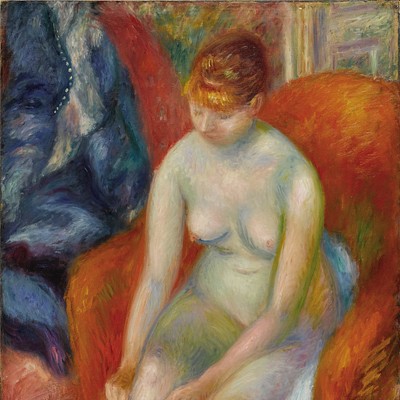Frederick Carl Frieseke, 1874-1939
Lot 154
Estimate:
$80,000 - $120,000
Absentee vs Live bid
Two ways to bid:
- Leave a max absentee bid and the platform will bid on your behalf up to your maximum bid during the live auction.
- Bid live during the auction and your bids will be submitted real-time to the auctioneer.
Bid Increments
| Price | Bid Increment |
|---|---|
| $0 | $10 |
| $100 | $25 |
| $500 | $50 |
| $1,000 | $100 |
| $2,000 | $250 |
| $5,000 | $500 |
| $10,000 | $1,000 |
| $20,000 | $2,500 |
| $50,000 | $5,000 |
| $100,000 | $10,000 |
About Auction
By Collector Fine Art Auctions
Feb 4, 2023
Set Reminder
2023-02-04 11:30:00
2023-02-04 11:30:00
America/New_York
Bidsquare
Bidsquare : Fine European / American Paintings & Furniture
https://www.bidsquare.com/auctions/collector-fine-art-auctions/fine-european-american-paintings-furniture-12048
Collector Fine Art Auctions February 4, 2023 / 11:30 am European / American Paintings & Furniture. First Annual Sale from Tuxedo Park NY, 150 Central Park South NYC, Princeton NJ Collector Fine Art Auctions cfaauction@gmail.com
Collector Fine Art Auctions February 4, 2023 / 11:30 am European / American Paintings & Furniture. First Annual Sale from Tuxedo Park NY, 150 Central Park South NYC, Princeton NJ Collector Fine Art Auctions cfaauction@gmail.com
- Lot Description
Title: Girl with a Basket of Ribbons, painted by 1915
Medium: Oil on panel. Signed lower right: F.C. Frieseke
Size: 31-3/4 x 25-1/4 in. (80.6 x 64.1 cm.)
PROVENANCE:
Private collection, circa 1930.
By descent to the present owner.
Ford Art Auctions May28,2019 lot #0038
PROPERTY FROM THE JANE W. PETTUS TRUST, SAINT LOUIS, MISSOURI
EXHIBITED:
Saint Louis Art Museum, Saint Louis, Missouri, "Impressionism Reflected: American Art, 1890-1920," May 6-June 27, 1982.
LITERATURE:
Saint Louis Art Museum, Impressionism Reflected: American Art, 1890-1920, exhibition catalogue, Saint Louis, Missouri, 1982, n.p.
Frederick Carl Frieseke's Girl with a Basket of Ribbons is an exquisite example of the intimism practiced by the American artists in Giverny. This genre, developed by the Nabis, featured artfully posed female models in decorative interiors illuminated by natural light. With its subtle light and beautiful tonal harmonies, Girl with a Basket of Ribbons demonstrates Frieseke at the height of his abilities.
Frieseke was one of the leading figures among the second generation of American expatriates in France. He first studied at the Art Institute of Chicago and the Art Students League in New York before leaving for Paris in 1898 to continue his studies. There Frieseke enrolled at the Académie Julian and at the Académie Carmen, James McNeill Whistler's short-lived school. Whistler's passion for Japanese art, for decoration, and for distinctive color arrangements had a lasting influence on Frieseke's work. By 1900, Frieseke was spending summers in Giverny and, after achieving artistic and financial success, was able to purchase a home there in 1906. He chose American Impressionist Theodore Robinson's former house next door to Claude Monet's. Like Monet, Frieseke found inspiration in the local landscape and the sunshine.
In the present work, Frieseke's model appears lost in reverie, with her fingers looped into the colorful threads of yarn in her basket. The mood is contemplative and serene. The basket set upon her lap at center creates a diagonal through the composition, juxtaposing the vertical and horizontal moldings on the wall of the room. The woman's curved chair unites the composition, instilling depth, balance, and harmony to the scene. The structure of the composition is similar to those of Édouard Vuillard. Both Vuillard and Frieseke often presented their figures in corners of rooms, viewing them diagonally and from a slightly elevated vantage point. While deeply influenced by the French Impressionists and the Nabis, Frieseke's compositions also possess techniques revolutionized by the post-Impressionists. As William H. Gerdts writes, "Frieseke's use of flat, interlocking patterns to achieve two-dimensional effects allies his art to French Post-Impressionism" (Monet's Giverny: An Impressionist Colony, New York, 1993, p. 174).
Frieseke was at the height of his career during the 1910s and early 1920s, when he painted Girl with a Basket of Ribbons and was perhaps the most popular of all living American artists. His ability to manipulate light and imbue his models with an air of psychological independence makes him one of the most accomplished American Impressionist painters of the female figure.
This painting will be included in the forthcoming catalogue raisonné of Frieseke's work being compiled by Nicholas Kilmer, the artist's grandson, and sponsored by Hollis Taggart Galleries, New York. - Provenance
- Shipping Info
-
Collector Fine Art Auctions requires "Third Party Shipping". We suggest requesting a quote for packing and shipping prior to bidding on an item, as you will be responsible for collection or shipping if you are the successful bidder. As a convenience to the buyer Collector Fine Art Auctions will make a referral for packing and shipping. This is at the request, expense and risk of the buyer and Collector Fine Auctions assumes no liabilities /responsibilities for the items or timing of delivery insurance for in transit items is the responsibility of the buyer Items need to be paid and picked up within 10 business days from close of Auction.
-
- Buyer's Premium



 EUR
EUR CAD
CAD AUD
AUD GBP
GBP MXN
MXN HKD
HKD CNY
CNY MYR
MYR SEK
SEK SGD
SGD CHF
CHF THB
THB















